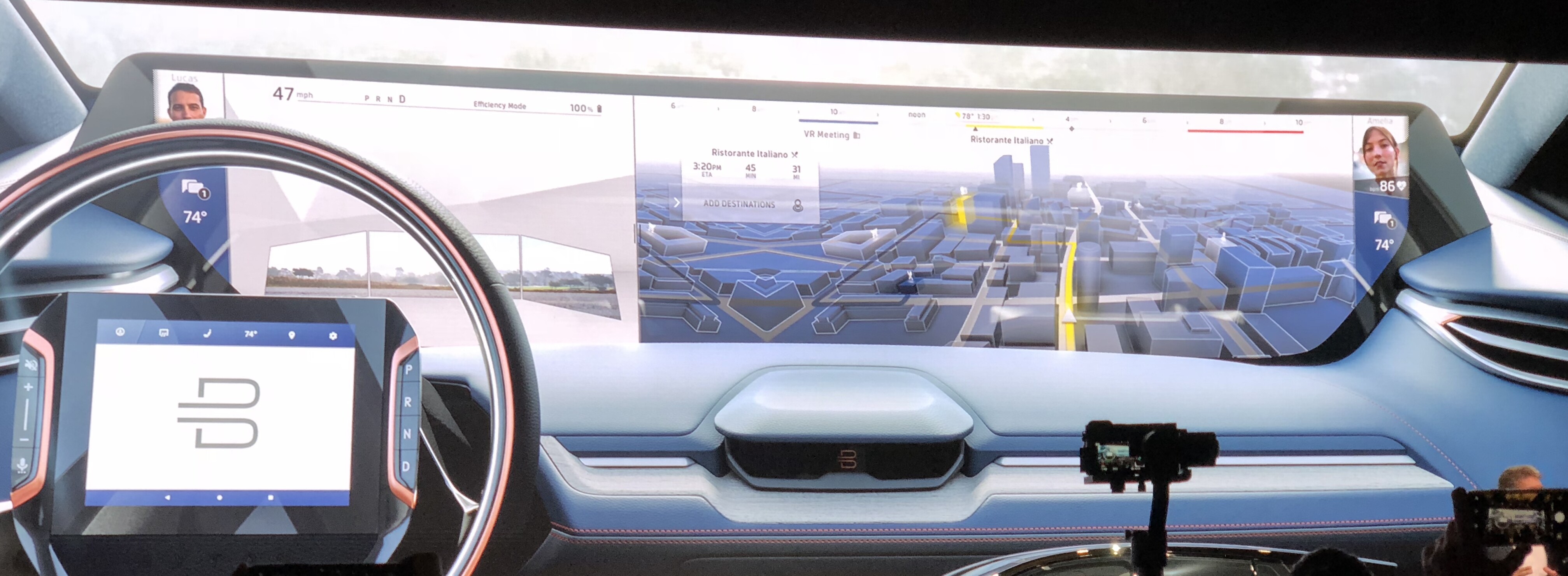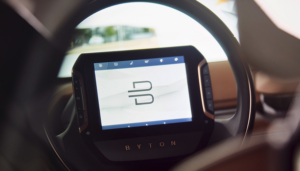In case you missed it, at the CES 2018 press day, new kid on the block, China car maker Future Mobility Corp. (FMC), launched its new electric car brand, Byton, that features a completely redesigned interior centering on a massive (1.25 meter) curved display running the width of the vehicle.

This, plus an insert display centered inside the steering wheel showed the company is looking at altering the human machine interface using the name “intelligent e-car”, creating what the company calls the “next generation smart device.”
This intelligent e-car, in the form of a $45K electric driver-less (autonomous) SUV prototype, became the instant darling of the first CES press day. The car creators, Dr’s. Carsten Breitfeld, and Daniel Kirchert came out riding in the self driving vehicle on stage at the standing room only press launch at the Mandelay Bay Hotel Casino, in Las Vegas.
The concept car will ship with level 3 autonomy in 2019. This technology still requires driver attention, but the driver “is not required to monitor the situation in the same way it does for the previous levels,” according to a report in TechRepublic.com. Byton said by 2020 it will upgrade to level 4 with the ability to perform all safety-critical driving functions and monitor roadway conditions for an entire trip (but limited to operational designed domain – not all driving conditions–that’s level 5).
 Curved display inside dashboard of new Byton shown at CES 2018, notice the display inside the steering wheel
Curved display inside dashboard of new Byton shown at CES 2018, notice the display inside the steering wheel
Byton calls it their “shared experience display,” and it replaces the driver information display (DID) and center console display (CSD) with this large format contiguous LCD panel that is meant to be shared with passengers. Display interface support includes voice recognition (supplied by Amazon’s Alexa), touch control, biometric identification plus physical buttons. They also include “proprietary air touch sensors” that allow all passengers (both front and rear) display control using hand gestures.
Byton placed a display inside the steering wheel of its self driving SUV, source: companyThe car interior was created with an eye toward driverless activity during the ride and is intended to allow full productivity including access to the web through its always on access to the cloud via what the Beijing based company calls its “life cloud platform”. The idea repeated at the press conference is to turn travel time into productive time (yikes, no down time!)
The group also said its life cloud will include “personalized services and configurations that are automatically adjusted to users’ preferences.” Other sensors include health monitoring such as heart rate, blood pressure and oxygen levels making the car akin to a “wearable device,” the company said.
Presumably this is a kind of seamless connection to specific apps, data and even content on devices like smartphones and tablets that are synced with the car. The firm also mentioned face recognition to open (and start) the car both for driver and passengers (nice).
The company says the stars are aligned (or quickly will be) with the technical foundations fast coming into place. These include the coming 5G mobile network, AI (artificial intelligence) and even the shared economy. Not to mention IoT (internet of things and car-2-car and car-2-infrastructure) plans that are unfolding almost daily.
Getting to market
The China-based startup Future Mobility corp. is a company that was initially formed by Chinese car dealer Harmony Auto, with funding also planned from smart device contract manufacturer Foxconn, and Tencent. The latter two have since pulled out leaving FMC looking for more capital, with other China-based investors including the Chinese government said to be stepping in. So far a reported $300M has been raised but an estimated $1.7B will eventually be required to mass produce the vehicles.
So ready or not this is the “dawn of the connected car, driven by electrification, connectivity and autonomous driving” with Byton at the center. To this Chinese car maker it is no longer about improving driving performance, rather “connectivity and technology” that will usher in the next generation driving (…or perhaps riding) experience with “the next generation smart device – Byton.” – We’ll see. Stephen Sechrist
Analyst Comment
There was a lot of hype at CES, but I have concerns over the safety of a tablet in the middle of the steering wheel and there are regulations in Europe that limit what the driver can see, so the seamless display might be an issue. Further, I saw a report this week that it will be some years before car companies can make money from in-car data and connectivity, and then only by selling data to insurance companies and others. Owners are likely to be reluctant to pay a monthly fee, so smart cars might be like smartTVs – good for the consumer (at least when the vehicle is new) but not a profitable deal for car companies. However, it’s hard to see how they avoid offering this kind of service without losing a lot of market share. (BR)
IHS: Autonomous Vehicle Sales to Surpass 33 Million Annually
New Video Shows Off Tesla Model 3 Touchscreen System
Auto Display Growth and Driver Preference
Tesla Roadster Shown at Truck Launch

